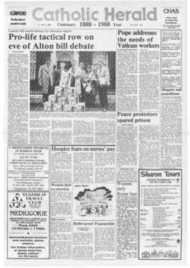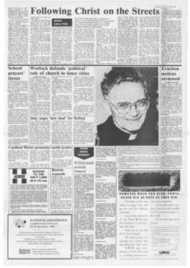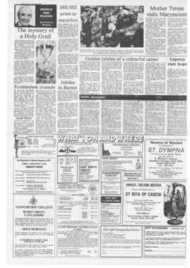Page 10, 6th May 1988
Page 10

Report an error
Noticed an error on this page?If you've noticed an error in this article please click here to report it.
Tags
Share
Related articles
Nuns And Scribes At Tyburn
Casting Fine On Cassette
Teddy Bears' Picnic At Tyburn
Tyburn Celebrates Avannal Hume Svia Lead Tributes To The...
50 Years Ago The 'women In Bonnets' Came To London . .
Be still with butterfly symbolism of Tyburn
BE STILL is the title of a splendid little magazine in which the Adorers of the Sacred Heart of Jesus of Montmartre, the Benedictine nuns of Tyburn Convent in London, share their spirituality with us. The current issue is remarkable for the clarity with which Mother Xavier McMonagle puts before us some of the writings of the foundress of the Adorers of the Sacred Heart, Mother Mary of St Peter (Adele Gamier). The first writings examined are her "Caterpillar" Document, and then her second, her "Raphael" document. Adele was about 28 years of age when she wrote of the caterpillar, the chrysalis and the butterfly.
In these writings we move from the bleak crawling existence of the insect condemned to eat leaves, to the chrysalis stage, where we are reminded that "while awaiting the resurrection the body is buried (or hidden) treasure in the earth". The butterfly stage is, of course, the reunion of the soul and body of a Christian at the resurrection. Adele's penpictures are ecstatic masterpieces of Christian philosophy.
In the same issue Mother John Baptist Brennan writes of "St Margaret Ward". I have heard so much propaganda, even from within the Church, from bishops and clergy, of how reluctant Good Queen Bess was to sentence women to death, that I had forgotten how Margaret Ward died at Tyburn, along with Irish waterman John Roche, seminary priest Richard Leigh of London, and laymen Edward Kelly of Sussex, Richard Flower of Wales, and Richard Martin of Shropshire.
Be Still does not have a price on it, but the Benedictine Sisters welcome any contribution towards the cost of production.
It is obtainable from Mother General, Tyburn Convent, 8 Hyde Park Place, London W2. If you drop into the chapel of Perpetual Adoration near Marble Arch you can arrange to pick up a copy.
WHEN His Holiness the Dalai Lama visited England last month, he was welcomed by Abbot Aldhelm; the Abbot of Prinknash, to a meeting of Benedictine monks and nuns, assembled at Archbishop's House, Westminster.
Among the many topics discussed on inter-faith dialogue was the possibility of a Benedictine monk spending up to two years in a Tibetan Monastery in India, teaching Patrology and learning Tibetan, with a view to translating such key works as the famous Rule of St Benedict into Tibetan.
THE Japanese Ambassador and Madame Chiba gave a reception in honour of one of Japan's most prominent writers, Shusaku Endo, who is a Catholic, and whose works are deeply rooted in Catholic philosophy. His latest book, a best seller in Japan, Scandal, was published in English last week by Peter Owen Ltd.
Shusaku Endo, pictured above, was born in Tokyo in 1923. After his parents divorced, he and his mother became Catholics. He graduated in French Literature from Keio University, and, in 1950, he went to France for several years to continue his studies on French Catholic writers at Lyons University.
Mr Endo has made his name in Japan as a leading writer of novels, essays and drama. He has won several prestigious literary awards in Japan: the Akutagawa Prize, the Mainichi Cultural Prize, the Shincho Prize, the Tanizaki Prize and the Noma Prize. He has also been elected to the Japanese Academy of Arts.
One of his early novels, The Sea and Poison (Umi to Dokuyaku), centres on the ethical dilemma faced by doctors at Kyushu University ordered to conduct medical experiments on living people. Perhaps his most representative work is Silence (Chinmoku). It is set during the time of persecution of Christians in Japan.
Graham Greene has described Mr Endo as "one of the finest living novelists".
IF YOU are visiting the West Country this summer on holidays, then I recommend a visit to John Leach, the Potter, in Muchelney, Somerset. At his rambling cottage in Muchelney you can purchase, at very reasonable prices, some examples of the very practical works of art by one of the world's greatest craftsman in wood-fired ceramics.
All his pieces are individual, and any purchase can become a valuable yet practical family heirloom, be it a jug, a breadcrock. a soup bowl or a casserole dish. A Leach pot is something of eternal beauty, a sheer delight to look at. No wonder you will find American tourists, with taste, making a pilgrimage to Muchelney, for the works of a man whose pottery is in collections all over the world from the V and A to Tokyo.
Says John Leach of his work: "I suddenly realise now at the age of 48 that I have been making pots for 30 years. My training started with a five year apprenticeship with my father, David, which included two periods with Ray Finch and one with Colin Pearson and nearly three years with my grandfather, Bernard. In 1963, after my apprenticeship finished I took up a teaching position in Mendocino, California. This led to the valuable experience of meeting and partnering Harold Guilland in the setting up of the Mendocino Pottery.
"I established Muchelney Pottery in Somerset in 1964 with my wife Lizzie and family. Looking back over my life, 24 years later, I feel indebted to my father, grandfather, Ray Finch and Colin Pearson who were instrumental in forming my ideas and themes on pottery which I still embrace. I did not have any formal art school training, therefore I tend not to be academic in my approach, but have grown out of a strong workshop tradition disciplined in the production of functional pottery.
"The pottery consists of Lizzie and myself as partners with my permanent assistant, Nick Rees, who is vital in the day to day running of the pottery. He did a five year apprenticeship with us and has now been here nearly 16 years. The team is completed, at present, by our student, Bridget Duxbury, who studied ceramics at Camberwell School of Art before coming here where she will stay for two years."
I WROTE recently about the appointment of James O'Donnell, the new Master of Music at Westminster Cathedral, which has prompted Fr Herbert Keldany to remind me of the rich heritage of music in the Cathedral in the person of Richard Terry, who died 50 years ago this month. Says Fr Keldany: "Richard Terry was born January 3, 1865 at Ellington in Northumberland. He really showed an early interest in music, went up to Oxford aged 21 and transferred to Cambridge two years later on getting a choral scholarship at King's College. "There he laid the foundation of his musical career, which took him from the high tide of Victorian music to the peak of the great revival of the ancient chant of the Church as well as the rediscovery of poliphon y which gave him an unrivalled lead at Westminster Cathedral in the early part of this century.
"To account for his achievement it must be recognised that this mercurial enthusiast was never satisfied with anything but the best. This partly is explained by the fact that he became a Catholic at the London Oratory at the age of 30.
"But he became a convert in music as well as religion. At Downside Abbey he was captivated by the treasures of plainchant, but he also began to revive old English music in his motets and introduced poliphony.
"It was this variety which caused Cardinal Vaughan, at the opening of Ealing Abbey to exclaim 'This is the music I want for my new Cathedral.'
"So two years before the opening of Westminster Cathedral Terry became its organist and choirmaster in 1901. He had a free hand, worked hard often in the face of misunderstanding for the next 23 years.
"Discovering, editing, singing the chant required by the Motu Proprio of Pope Pius X would have been enough for a lesser man. But he covered the early masters like Byrd and the poliphony of Palestrina and many others.
"He retired after 24 years soon after he had become Sir Richard Terry. One of his best known creations was the Christmas Carol Service which is still perfomed by the Westminster Cathedral Choir."
Gerard Noel is away
blog comments powered by Disqus











